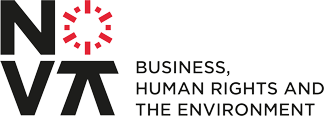Dr. Siniša Milatović is a Business, Human Rights and Peace Specialist with UNDP HQ, providing expertise and support to governments, businesses, civil society and other stakeholders. Siniša has 25 years’ experience as a human rights lawyer. He has worked for UN agencies and other organisations in over 40 countries in Asia and the Pacific, Africa, the Arab States region, Europe and Central Asia. Siniša has a DPhil with a focus on business and human rights from the Faculty of Law at the University of Oxford. He also holds an MA from the Fletcher School of Law and Diplomacy and an LLB from the London School of Economics and Political Science.
Dr. Olena Uvarova, Business, Human Rights and Rule of Law Specialist with UNDP HQ. She has over 20 years of experience working with companies, governments and international organisations. Olena is also an Associate Professor at Yaroslav Mudryi National Law University in Ukraine, where she has led the International Business and Human Rights Laboratory since 2018. She is Co-Founder of the Regional Business and Human Rights Association in Central and Eastern Europe and Central Asia, and since 2023 has served as Co-President of the Global Business and Human Rights Scholars Association.
We would like to thank Dr. Dorothée Baumann-Pauly for her engagement with our research recently published by UNDP (Human Rights vs Competitiveness: A False Dilemma?) in her blog, “Human Rights and Competitiveness: Debunking a Myth or Creating a New One?”. A debate is essential for advancing the field of business and human rights, and we welcome the opportunity to clarify the contributions of the study.
While Dr. Baumann-Pauly raises important questions, some aspects of her critique appear to rest on interpretations that differ from how the study’s methodology and metrics were designed, including the study’s core financial metric, its longitudinal methodology, its treatment of costs, and the nature of the Corporate Human Rights Benchmark (CHRB) data used. Our objective here is to address these points directly to ensure a more accurate understanding of the research and its implications.
1. The Core Financial Metric: the Comprehensive Nature of Return on Assets (RoA)
A central pillar of the critique is an alternative interpretation of the study’s primary financial performance metric. The blog authored by Dr. Baumann-Pauly refers to “Return on Investments,” but our analysis focuses on Return on Assets (RoA). This distinction is important, as RoA forms the basis of our analysis.
RoA is calculated as a company’s Net Income divided by its Total Assets. Its comprehensive nature is precisely why it was chosen as a financial metric in our study:
- RoA systematically accounts for all costs: The numerator, net income, is an accounting measure calculated after all operating, administrative, and interest expenses have been deducted. This means that all tangible costs associated with human rights due diligence (HRDD) – be it staff salaries, supplier audits, new tracing technologies, or remediation processes – is already accounted for in the net income, and therefore in the metric. In this context, the assertion that our analysis ignores costs appears, from our view, to be a misunderstanding of how RoA operates, as the costs are embedded in the very structure of the RoA calculation. If HRDD were purely a financial drain, it would mechanically lower net income and, consequently, depress RoA.
- RoA measures operational efficiency: The ratio as a whole measures how efficiently a company uses its assets to generate profit. The theorised benefits of HRDD – such as more resilient supply chains, reduced operational disruptions, and a more productive and stable workforce – are factors that directly enhance asset efficiency.
- The “alternative” business case is already included in the RoA: The critique suggests we should focus on factors like “worker productivity, strengthened community relations, […] trust, resilience, and stakeholder commitment.” These factors are in fact closely connected to financial outcomes. From a business case perspective, these are not competing ends but rather crucial mechanisms that drive financial performance. Enhanced worker satisfaction leads to lower turnover, reducing recruitment and training costs. Stronger community relations mitigate the risk of costly operational shutdowns. Stakeholder trust can translate into a better reputation, increased sales, and more favourable access to capital. These benefits are not abstract concepts that exist separately from financial statements; they are tangible value drivers that are ultimately reflected in a company’s bottom line – and are therefore captured by RoA.
The critique therefore appears to treat costs and benefits as separate from financial metrics, whereas RoA integrates them into a single indicator.
2. Clarifying the Study’s Stance on Costs and Time Horizon
The critique suggests that the UNDP study implies there is no cost to respecting human rights. On the contrary, our report is explicit: page 7 clearly states “Improving corporate human rights conduct involves real investments” and “the upfront investments are tangible.”
The central research question was not whether HRDD requires upfront costs– because it’s clear it does – but whether these investments result in a net financial penalty over time. To test this, we employed a longitudinal, change-on-change methodology over a five-year period. This design was chosen specifically to analyse the dynamic relationship between an investment in human rights performance at one point in time and the subsequent financial outcome years later.
The critique’s focus on “immediate costs and uncertain future benefits” is precisely the hypothesis we tested. Our findings do not deny the former but provide empirical evidence that, over a medium-term horizon, the latter can materialise to a degree that offsets the initial investment. Engaging with this five-year design is essential to fully understanding the study’s methodological contribution.
3. Interpreting the Corporate Human Rights Benchmark (CHRB) in the Context of our Analysis
The critique posits that the CHRB “only assesses management systems, not actual corporate performance.” This interpretation does not, in our view, accurately reflect the CHRB methodology.
While the CHRB relies on publicly available data, its methodology is explicitly designed to move beyond a simple review of policies. A significant portion of its indicators requires companies to provide evidence of action and implementation. As our report details, companies are assessed on whether they:
- Provide examples of specific actions taken on salient human rights issues
- Describe how human rights findings influence core business decisions (e.g., supplier relationships)
- Disclose how they approach remedy when adverse impacts occur.
This emphasis on practice-oriented indicators makes the CHRB considerably more robust than a simple disclosure checklist. While no large-scale benchmark can perfectly capture every on-the-ground reality, the CHRB is the best-in-class tool for systematically assessing the corporate architecture that is a prerequisite for respecting human rights. Furthermore, the critique’s use of general statistics from a recent CHRB “State of Play” report may lead to an inaccurate impression, as our study relies on a consistent, longitudinal dataset of 235 specific firms over a five-year period.
4. The Critique of Empirical Proxies
Dr. Baumann-Pauly’s blog criticises the use of “weak proxies”; the general concern about using the right proxies in studies is important and one we share, but the critique does not suggest an alternative approach for empirically testing the financial implications of corporate human rights performance.
All large-scale quantitative analysis of complex social phenomena relies on proxies. Applying a standard that rejects all proxies would also challenge many widely accepted empirical approaches in related fields, including the very indices that measure the relationship between the rule of law, democracy, and economic development at the national level. Unless we abandon empirical inquiry altogether, we must use the best available indicators.
The purpose of UNDP’s study is not to instrumentalise human rights or reduce them to a financial metric. We state this explicitly (p.14). The moral and legal imperatives to respect human rights stand on their own. Our goal is to empirically test the pervasive – and, as our research shows, largely unfounded – assumption that respecting human rights harms competitiveness. This assumption acts as a powerful brake on corporate action and ambitious public policy. By providing evidence to the contrary, we aim to remove this barrier.
Conclusion: Challenging an Old Myth, Not Creating a New One
There is a clear tension in the critique’s framing. It argues that our study risks creating a ‘new myth’ of profitability, yet the ‘alternative’ business case it advances—centred on worker retention, consumer loyalty, and enhanced reputation—is itself premised on generating long-term financial value.
Indeed, this “alternative” business case has been made repeatedly in various papers over the years. While compelling (as we state in the paper, we also believe that improved human rights performance leads to better reputation, worker retention, etc.), it has been difficult to quantify these benefits and compare them directly to the costs of HRDD. Thus, while worker retention and consumer loyalty are important, they are not – for companies – an end in itself, but a means to an end towards improved financial performance. Our paper attempts to quantify whether these benefits outweigh the costs of HRDD using financial metrics, such as RoA, that account for both.
In that respect, Dr. Baumann-Pauly’s critique does not argue against a business case for human rights; it simply argues for a different articulation of it, the components of which are already accounted for in our methodology.
Rather than creating a new myth, UNDP’s study applies established methods to test a longstanding assumption in the field: the idea of an unavoidable trade-off. By demonstrating the financial viability of respecting human rights, this study clears the path for business leaders, investors, and policymakers to move the conversation from “if we can afford to act” to “how we can best integrate human rights into core strategy for long-term resilience and shared value.”
Finally, it is crucial to reiterate a point we emphasise in the report itself: this study is presented as one step in a long-term research agenda. This is precisely why we dedicated a specific section to a transparent discussion of the study’s methodological limitations – from the challenges of definitively proving causation to the reliance on proxies – limitations that we ourselves identified and that now form the basis of our next steps. We view this as a living project and actively welcome collaboration and constructive engagement from the entire business and human rights community, including from our critics. The challenges are complex, and only by working together can we collectively strengthen the evidence base and move from entrenched assumptions to data-driven insights.
Suggested citation: S. Milatović and O. Uvarova,, ‘”Human Rights vs. Competitiveness: A False Dilemma?” – Response to Dorothée Baumann-Pauly’, NOVA BHRE Blog, 17 November 2025

